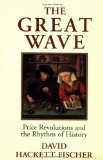J. T. Dobbs at American Drink asks,
Is it a coincidence that on the heels of one of the worst economic crises since The Depression, artisan cocktails began making a huge comeback?
Actually, no, it’s not. It’s typical.

In The Great Wave: Price Revolutions and the Rhythm of History, David Hackett-Fischer observes that when the going gets tough, the tough get to drinking. Figure 4.24 on page 227 shows a remarkable correspondence between the rate of inflation and consumption of distilled liquor. As Mr. Hackett-Fischer notes in the caption,
[L]iquor consumption and drug use peaked when real incomes were falling rapidly, prices were surging and unemployment was increasing. A comparable surge in drinking (to the highest recorded levels in American history) occurred in similar circumstances during the climactic years of the eighteenth century price revolution. A long decline in alcohol consumption coincided with the Victorian equilibrium.
The Bureau of Labor Statistics publishes data on expenditures on alcoholic beverages, and the Centers for Disease Control do the same for alcohol consumption. Historical data on alcohol consumption is a little harder to locate at the CDC than it is at the OECD. Both data sets lag by a few years.
Expenditures and consumption are not the same things, since price per unit of alcohol varies. Strangely, expenditures are falling, and have been. Consumption in the United States was decreasing from 1983 to 2000, but since 2001 is back on the increase. Since I’ve not noticed the prices dropping, purchasers are likely shifting consumption to cheaper products without reducing overall consumption. This could be either a switch from Dogfish Head to Budweiser, which I doubt, or from beer to distilled liquor, and, thus, cocktails.